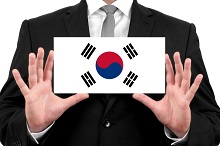A Bright Future for Korean Translation and Interpreting
March 9, 2015

Now that the Korean TV drama boom and the K-pop tidal wave are taking something of a break, let us look at the current state of Korean translation and interpreting.
The structure of the Korean language is often said to be similar to that of Japanese, which at first glance leads Japanese people to think of Korean translation and interpreting as a rather simple proposition. This article looks at various facets of this field, including the state of demand, key features, and future prospects.
The Demand for Korean Translation and Interpreting
When they hear of Korean translation and interpreting, many Japanese people nowadays probably think of translating K-pop lyrics or interpreting for Korean soap opera stars. But in fact most of the demand for Korean translation and interpreting arises from the tourism and business sectors.
A remarkable and noteworthy trend in Korea over recent years has been the growth of sub-sections devoted to Korean translations of Japanese literature in the foreign translated literature sections of Korean bookstores. In 2010, some 832 Japanese literary works were translated into Korean for the foreign translated literature sector. This figure accounted for 35.8% of the total in that sector, far ahead of any other country.
Some Key Features of Korean Translation and Interpreting
Japan and Korea are situated close to each other geographically, and the languages of the two countries share a number of grammatical similarities. Given this, the cultural and linguistic gaps confronting Japanese-Korean translation and interpreting are considered to be small compared with those involving other languages.
However, if we listen to the language of the Koreans, who are sometimes called "the Italians of Asia," they often seem to express themselves very clearly and openly. For example, a Korean TV star might say "sarang hae yo" to a fan, which could be directly translated by a Japanese as "I love you (enough to risk my life for you)." But in fact, this should often just be regarded as a simple message akin to "Cheer for me." Not infrequently, a direct translation can convey the wrong nuance.
Also, Korean people often speak in the first person, and unlike Japanese people they rarely speak in such a way as to leave the subject of the sentence unclear. A translator or interpreter who takes this into consideration, identifying natural-sounding expressions for both parties and minimizing any risk of miscommunication, would be demonstrating real skill.
The Future Prospects of Korean Translation and Interpreting
From an economic standpoint, the great rapidity with which the IT and especially the software sectors have developed in Seoul and the rest of Korea over recent years has been eye-opening. Behind this rapid growth however, it is also a fact that there is a shortage of skilled people who can localize Korea's outstanding technological products for export to other countries.
That is to say, Korean language translators and interpreters hold the key to large returns to be had in both Japan and Korea. The demand for translation is forecast to expand in coming years, and translators and interpreters can look forward to active and growing roles.
Summary
Korea is geographically close to Japan. The presence of Japanese-Korean translators and interpreters who busy themselves building bridges between Korea and Japan harbors great potential for Japan where globalization is moving forward. For Japanese companies that are planning to set up operations in Korea and that seek to overcome cultural and linguistic barriers, facilitate communication between Japanese and Korean counterparts and thus generate better outcomes, the quest to secure outstanding Japanese-Korean translators and interpreters is likely to be a major issue.
Related Services
| << Another Face of Japanese Hospitality: the Increasing Demand for Menu Translations | Quality Control in Translation >> |
To Contact Us Regarding Our Translation Services
For urgent needs, call:
+81-3-5730-6133
